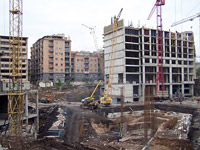The International Monetary Fund forecast earlier this month that the Armenian economy will shrink by 5%. Three days ago the Central Bank of Armenia (CBA) for its part made a further downward revision of its economic outlook ahead of the release of the fresh NSS figures. The CBA said it expects a GDP fall of 5.8 percent this year.
However, when one grows through the freshest state statistical data it becomes clear that the predictions of the IMF and the CBA are not pessimistic but very optimistic. The GDP of Armenia decreases by 9, 7 percent, the state collects debts from foreign countries, and the Yerevan City Hall covers with flowers the bridges and the subways of Yerevan and increases the number of lightened streets and lanes. All this is made on account of the money from the budget. Gross Domestic Product (GDP) reduced by 9.7% in Armenia in January-April 2009 against the same period of last year. The RA National Statistical Service reported that the GDP totaled 638.9bln Drams. GDP produced in April only was by 5.4% lower than that recorded in the previous month. A 9.3% economic growth was recorded in January-April this year. A 9.2% economic growth was planned in Armenia for 2009 under the state budget. Reminder: the slump of January-March was 6.1% but in March the economy registered a 22.1% growth compared to February. All the sectors of economy suffered from decline without any exception. An almost 11 percent fall in four-month industrial output was the other key factor behind Armenia’s worsened macroeconomic performance. Industry generated about 28 percent of GDP during this period. Its leading export-oriented components, mining and metallurgy, has been hit particularly hard by the global economic crisis. Not surprisingly, Armenian exports tumbled by almost 48 percent to $175.6 million in January-April. The RA National Statistics Service reported the nominal of average monthly salary increased by 13.2% and reached 96,875 AMD in Armenia this January-April against January-April 2008. The average monthly salary in government-financed organizations reached 80,937 AMD, an annual increase of 17.9%. At the same time the average monthly salary increased by 0.2% this April against this March. The average monthly salary in privately-owned organizations reached 120,427 AMD, an annual increase of 7.4%, with a 2.2% increase against the previous month. The average monthly salary increased by 1.2% this April against this March. During the first 4 month of this year the production of electrical power amounted to 1878.5 million kilowatt, which is 12.4% less compared to the same period of the last year. In the background of these numbers the indices of importation and exportation will not be surprising. The foreign trade index was reduced by 30% and amounted to 1 billion 69 million USD. Importation decreased by 25% (893.5 million dollars) and exportation was reduced nearly twice – 52.2% and amounted to 175.6 million USD. Instead, the expenditures are tangible, which are made for electoral purposes, though in the form of the state program of greening and putting in good order Yerevan. The GDP of Armenia decreases by 9, 7 percent, the state collects debts from foreign countries, and the Yerevan City Hall covers with flowers the bridges and the subways of Yerevan and increases the number of lightened streets and lanes. All this is made on account of the money from the budget. The GDP in agriculture reduced by 4.1% and the amount of services decreased by 0.6%. The latest data from the NSS show that Armenia continues to be dragged deeper into recession by its troubled construction and industry sectors. Construction, one of the main engines of the country’s robust growth in recent years, contracted by as much as 42.4 percent in January-April 2009, sharply up from its first-quarter drop of 22 percent. In an effort to shore up the construction industry, the Armenian government approved last month at least 20 billion drams ($54 million) in credit guarantees for local real estate developers lacking cash to finish their construction projects. The sector’s accelerated decline in April suggests that the measure has had little impact so far. If in March construction registered 65% growth compared to February then in April the slump was 35.3% compared to March. In other words the more the state speaks about supporting this branch of economy the volume of construction decreases even more. And as a result if construction was the locomotive of the economy then now it is turned into ballast, which “provides” economic downward acceleration. Now let’s return to the economic indices of this year, which was predicted by the Central Bank and the IMF. The index was respectively 5% and 5.8%. Moreover, the prediction is made for the whole year. But during the first 4 months there has already been a 10% decline. As a matter of fact if things continue the same way we will only have to dream of the predicted 5% slump. But if the predictions of the IMF and the CB are justified the economy will soon revive. But we don’t see any traces of activation at this stage even judging from the data of the state statistics.

